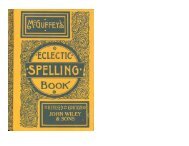WINE, WOMEN, AND SONG. - The Language Realm
WINE, WOMEN, AND SONG. - The Language Realm
WINE, WOMEN, AND SONG. - The Language Realm
You also want an ePaper? Increase the reach of your titles
YUMPU automatically turns print PDFs into web optimized ePapers that Google loves.
comparatively sterile in the department of prose composition, but it attained to high qualities of<br />
art in the verse and rhythms of men like Thomas of Celano, Thomas of Aquino, Adam of St.<br />
Victor, Bernard of Morlais, and Bernard of Clairvaux. At the same time, classical Latin literature<br />
continued to be languidly studied in the cloisters and the schools of grammar. <strong>The</strong> metres of the<br />
ancients were practised with uncouth and patient assiduity, strenuous efforts being made to keep<br />
alive an art which was no longer rightly understood. Rhyme invaded the hexameter, and the best<br />
verses of the medieval period in that measure were leonine.<br />
<strong>The</strong> hymns of the Church and the secular songs composed for music in this base Latin took a<br />
great variety of rhythmic forms. It is clear that vocal melody controlled their movement; and one<br />
fixed element in all these compositions was rhyme—rhyme often intricate and complex beyond<br />
hope of imitation in our language. Elision came to be disregarded; and even the accentual values,<br />
which may at first have formed a substitute for quantity, yielded to musical notation. <strong>The</strong> epithet<br />
of popular belongs to these songs in a very real sense, since they were intended for the people's<br />
use, and sprang from popular emotion. Poems of this class were technically known as moduli—a<br />
name which points significantly to the importance of music in their structure. Imitations of<br />
Ovid's elegiacs or of Virgil's hexameters obtained the name of versus. Thus Walter of Lille, the<br />
author of a regular epic poem on Alexander, one of the best medieval writers of versus,[10]<br />
celebrates his skill in the other department of popular poetry thus—<br />
"Perstrepuit modulis Gallia tota meis."<br />
(All France rang with my songs.)<br />
We might compare the versus of the Middle Ages with the stiff sculptures on a Romanesque font,<br />
lifelessly reminiscent of decadent classical art; while the moduli, in their freshness, elasticity, and<br />
vigour of invention, resemble the floral scrolls, foliated cusps, and grotesque basreliefs of Gothic<br />
or Lombard architecture.<br />
V.<br />
Even in the halflight of what used to be called emphatically the Dark Ages, there pierce gleams<br />
which may be reflections from the past evening of paganism, or may intimate the earliest dawn<br />
of modern times. One of these is a song, partly popular, partly scholastic, addressed to a beautiful<br />
boy.[1] It begins thus—<br />
"O admirabile veneris idolum"—<br />
and continues in this strain, upon the same rhythm, blending reminiscences of classical<br />
mythology and medieval metaphysic, and winding up with a reference to the Horatian Vitas<br />
hinnuleo me similis Chloe. This poem was composed in the seventh century, probably at Verona,<br />
for mention is made in it of the river Adige. <strong>The</strong> metre can perhaps be regarded as a barbarous<br />
treatment of the long Asclepiad; but each line seems to work out into [11]two bars, divided by a<br />
marked rest, with two accents to each bar, and shows by what sort of transition the modern<br />
French Alexandrine may have been developed.



